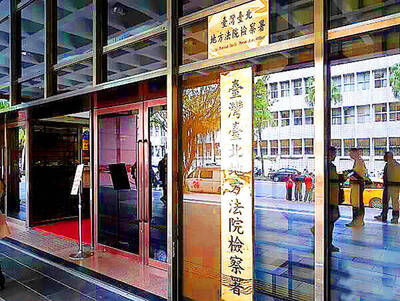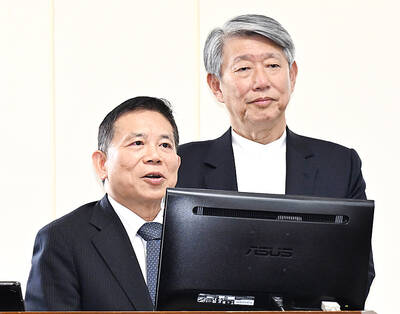The number of ballistic and cruise missiles aimed by China’s Second Artillery Corps at Taiwan has grown from 1,400 last year to more than 1,600 this year, which poses a serious threat to the nation, the Ministry of National Defense (MND) said in its China Military Power Report 2012.
This year’s annual report, which has been delivered to the legislature, emphasizes China’s growing missile threat.
It said the People’s Liberation Army had deployed a small number of advanced Dong Feng-16 (DF-16) missiles to complement the arsenal of DF-11 and DF-15 short-range missiles that has threatened Taiwan over the years. National Security Bureau Director Tsai Der-sheng (蔡得勝) told the legislature in March last year that the Chinese military had completed developing the new DF-16. Photographs in April suggested the deployment of the medium-range missile had begun. Military analysts also believe that the DF-16 may be mobile, which would make interception more difficult.
To increase area-denial, the Second Artillery has deployed DF-21D anti-ship ballistic missiles, the report said, adding that DF-31A ICBMs armed with nuclear warheads and capable of reaching the US and most European countries were deployed to deter other countries from interfering in any conflict in the Taiwan Strait.
The number of ballistic and cruise missiles aimed at Taiwan has increased by about 200 from last year and is now estimated at 1,600, it said, adding that an increasing number were equipped with advanced GPS systems allowing for precision attacks against Taiwan.
Facing an increased threat from Chinese missiles, plans are being made to modernize Taiwan’s air defense systems, the report said.
According to the military budget proposal for next year, the ministry has earmarked funds to modernize and expand its surface-to-air missiles (SAM), with the ministry planning to procure rocket boosters from the US to place on the AIM-120 advanced medium-range air-to-air missile. It also has plans to acquire AGM-65G Maverick missiles, AGM-84L Harpoon missiles and Magic II missiles, as well as the domestically produced Tien Chien II missiles.
The Chungshan Institute of Science and Technology is also to be called upon to modernize parts of the indigenous Tien Kung “Sky Bow” I and II air-defense systems.
The military also plans to send aging MIM23 Hawk medium-range SAMs to the US for efficiency tests, the budget proposal shows.
In addition, the military plans to procure rocket motors from the US to equip its Standard Missile 1, it says.
Although relations across the Taiwan Strait have improved, China has not slowed its military buildup, which is mainly intended to deter the Taiwanese independence movement, the report says.

Intelligence agents have recorded 510,000 instances of “controversial information” being spread online by the Chinese Communist Party (CCP) so far this year, the National Security Bureau (NSB) said in a report yesterday, as it warned of artificial intelligence (AI) being employed to generate destabilizing misinformation. The bureau submitted a written report to the Legislative Yuan in preparation for National Security Bureau Director-General Tsai Ming-yen’s (蔡明彥) appearance before the Foreign Affairs and National Defense Committee today. The CCP has been using cognitive warfare to divide Taiwanese society by commenting on controversial issues such as Taiwan Semiconductor Manufacturing Co’s (TSMC, 台積電) investments in the

INVESTIGATION: The case is the latest instance of a DPP figure being implicated in an espionage network accused of allegedly leaking information to Chinese intelligence Democratic Progressive Party (DPP) member Ho Jen-chieh (何仁傑) was detained and held incommunicado yesterday on suspicion of spying for China during his tenure as assistant to then-minister of foreign affairs Joseph Wu (吳釗燮). The Taipei District Prosecutors’ Office said Ho was implicated during its investigation into alleged spying activities by former Presidential Office consultant Wu Shang-yu (吳尚雨). Prosecutors said there is reason to believe Ho breached the National Security Act (國家安全法) by leaking classified Ministry of Foreign Affairs information to Chinese intelligence. Following interrogation, prosecutors petitioned the Taipei District Court to detain Ho, citing concerns over potential collusion or tampering of evidence. The

‘COMPREHENSIVE PLAN’: Lin Chia-lung said that the government was ready to talk about a variety of issues, including investment in and purchases from the US The National Stabilization Fund (NSF) yesterday announced that it would step in to staunch stock market losses for the ninth time in the nation’s history. An NSF board meeting, originally scheduled for Monday next week, was moved to yesterday after stocks plummeted in the wake of US President Donald Trump’s announcement of 32 percent tariffs on Taiwan on Wednesday last week. Board members voted to support the stock market with the NT$500 billion (US$15.15 billion) fund, with injections of funds to begin as soon as today. The NSF in 2000 injected NT$120 billion to stabilize stocks, the most ever. The lowest amount it

NEGOTIATIONS: Taiwan has good relations with Washington and the outlook for the negotiations looks promising, Minister of Economic Affairs J.W. Kuo said Taiwan’s GDP growth this year is expected to decrease by 0.43 to 1.61 percentage points due to the effects of US tariffs, National Development Council (NDC) Minister Paul Liu (劉鏡清) said at a meeting of the legislature’s Economics Committee in Taipei yesterday, citing a preliminary estimate by a private research institution. Taiwan’s economy would be significantly affected by the 32 percent “reciprocal” tariffs slapped by the US, which took effect yesterday, Liu said, adding that GDP growth could fall below 3 percent and potentially even dip below 2 percent to 1.53 percent this year. The council has commissioned another institution